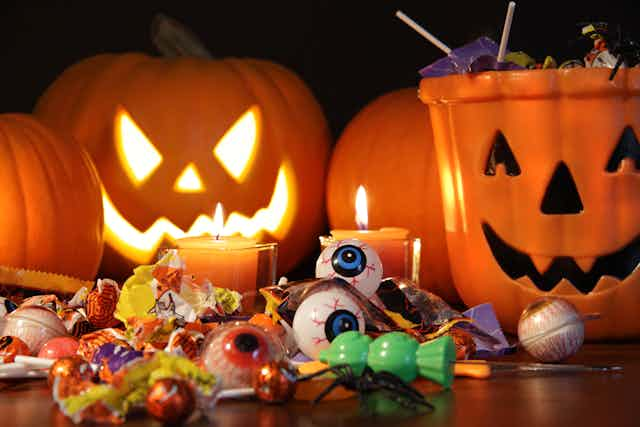Halloween is upon us, and children of all ages are gearing themselves up for an evening of trick-or-treating. But a night of spooky celebrations is not always as mellow and wholesome as some would hope. Increasingly, the streets aren’t well-lit with cheery ghosts hanging from trees, and children aren’t being escorted from door to smiling neighbours’ door by parental escorts. Instead, the little ones are being directed to carefully selected houses, as concerns creep in over the safety of children on All Hallows’ Eve.
From poisoned sweets placed in childrens’ goody bags to pins, needles and razor blades hidden inside larger treats, the same rumours around Halloween trick or treating persist from year to year.
Fact-checking and myth debunking website Snopes reports that police in the US have no documented case of tampered-with candy being handed out randomly to children. US criminology professor Joel Best likewise has found little evidence of other tampered-with Halloween treats intended to harm the little ones who eat them.
Though they may be false, these stories provide interesting examples of how cultural anxieties about keeping children safe sometimes focus on risks that fit into cultural norms, at the expense of risks that are quantifiably greater.
Tricks in treats
The few cases that do exist of children being harmed by trick-or-treat sweets actually challenge the idea that children are at significant risk from menacing strangers who wish them harm.

Two of the most high profile and tragic stories linked to Halloween treats are as follows. A young boy died in 1970 after ingesting heroin that his parents said had been in his Halloween sweets, and another boy died in 1974 after eating a sweet laced with cyanide. It was later revealed that the first child had found the heroin in a relative’s house. In the case of the second, the father was convicted of intentionally poisoning his son in order to collect on a life insurance policy.
What’s notable about these tragedies is that in one case, the death was accidental, and not actually related to Halloween. In the other, it wasn’t a stranger or even a neighbour who murdered the child, but his own father. These stories are almost the opposite of the fear of Halloween opening the door for anonymous threats to children. They are actually about how some families are not the ideals of safety and comfort that we often imagine them to be.
There is another tricky case of treat tampering that, though the actions certainly endangered youngsters, also calls into question where we place our concerns on Halloween.
In 1964, New York housewife Helen Pfeil was convicted of child endangerment after giving out arsenic-laced ant poison buttons to trick-or-treaters. Her intention was to give packages of “treats” to those she thought were too old to be asking for free sweets. Each package, which contained either the tablets, steel wool pads or dog biscuits, was clearly marked “poison” and labelled with a skull and crossbones. Though no one reported any harm from Pfeil’s “joke”, by trying to preserve trick-or-treating as an activity for younger children, this woman was putting actual children at risk.
Though her actions were certainly questionable, it is important to note that Pfeil’s motivation does not exist in a vacuum. It is generally accepted that there is a certain age after which trick-or-treating is seen as inappropriate. These children – teenagers, to be more accurate – are seen as a threat themselves when they are deemed too old for the child’s play of Halloween revelry.

This speaks to the difficult relationship our society has with ideas around childhood. Our culture, including the culture around trick-or-treating, is built on a foundation of protecting children from danger. But when children are construed as a danger themselves, this undermines the broader idea of the child as a perfect innocent, in need of protection.
Founded fears
Of course, children do need protection, and of course people worry about children, both as individuals and as part of society. Trick-or-treating is an activity that overtly raises questions about how to keep children safe, because its very nature runs against the advice that we give to children about staying safe. Don’t take candy from strangers, we say, unless it’s Halloween.
There is some recent evidence that shows how worries about trick-or-treating have changed focus to concerns about sexual predators rather than treat tamperers. But research on child sex crime rates has found that such incidents don’t increase on or around Halloween.
However, there is at least one threat to children that does spike substantially on Halloween: one study from the United States found a fourfold increase in youth deaths in pedestrian-automobile accidents on Halloween nights. Sadly, this is not quite as scary or popular a warning narrative as that of a potential murderer waiting with bait to trap children who dare knock on their door.
Quite clearly, the actual, quantifiable risks and the more widespread cultural anxieties around Halloween are disconnected from one another. And this disconnect emphasises how mundane dangers, those without malicious intent, and those that exist within the family home attract far less focus than risks that are placed outside the family or outside of everyday experiences.

